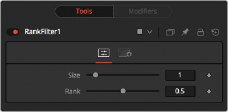
< Previous | Contents | Next >
This control has a range from 0 to 315 degrees and changes the effect in increments of 45 degrees. This applies only to the Relief and Emboss filters.
Depending on which Filter Type is selected, the Median control may appear. It varies the Median filter’s effect. A value of 0.5 produces the true median result, as it finds the middle values. A value of 0.0 finds the minimums, and 1.0 finds the maximums. This applies to the Median setting only.
This control is visible only when applying the Grain or Noise filter types. The Seed slider can be used to ensure that the random elements of the effect are seeded with a consistent value. The randomizer always produces the same result, given the same seed value.
This control is visible only when applying the Grain or Noise filter types. Select the checkbox to cause the noise or grain to change from frame to frame. To produce static noise, deselect this checkbox.
Common Controls
The Settings tab controls are common to all Filter nodes, so their descriptions can be found in “The Common Controls” section at the end of this chapter.
Rank Filter Node [RFlt]

![]()
The Rank Filter node
Rank Filter Node Introduction
The Rank Filter examines nearby pixels, sorts the pixels by value, and then replaces the color of the examined pixels with the color of the pixel with the selected rank.
Inputs
The Rank Filter node includes two inputs: one for the main image and the other for an effect mask to limit the area where the filter is applied.
— Input: The orange input is used for the primary 2D image that gets the Rank filter applied.
— Effect Mask: The optional blue effect mask input accepts a mask shape created by polylines, basic primitive shapes, paint strokes, or bitmaps from other tools. Connecting a mask to this input limits the rank filter to only those pixels within the mask. An effects mask is applied to the tool after the tool is processed.
Basic Node Setup
The Rank Filter node can be placed anywhere in a node tree to apply an effect to an image.

A Rank Filter node placed after a MediaIn node in DaVinci Resolve
Inspector

l
l
l
Rank Filter controls
Controls Tab
The Controls tab is used to set the size and rank value of the filter.
This control determines the size in pixels of the area sampled by the filter. A value of 1 samples 1 pixel in each direction, adjacent to the center pixel. This produces a total of 9 pixels, including the center sampled pixel. Larger values sample from a larger area.
![]()
Low Size settings are excellent for removing salt and pepper style noise, while larger Size settings produce an effect similar to watercolor paintings.

Example
Below is a before and after example of a Rank filter with Size set to 7 and a Rank of 0.7 to create a watercolor effect.
Example
Below is a before and after example of a Rank filter with Size set to 7 and a Rank of 0.7 to create a watercolor effect.
Example
Below is a before and after example of a Rank filter with Size set to 7 and a Rank of 0.7 to create a watercolor effect.
Before and after of a Rank Filter producing a watercolor-style effect
Before and after of a Rank Filter producing a watercolor-style effect
Before and after of a Rank Filter producing a watercolor-style effect
The Rank slider determines which value from the sampled pixels is chosen. A value of 0 is the lowest value (darkest pixel), and 1 is the highest value (brightest pixel).